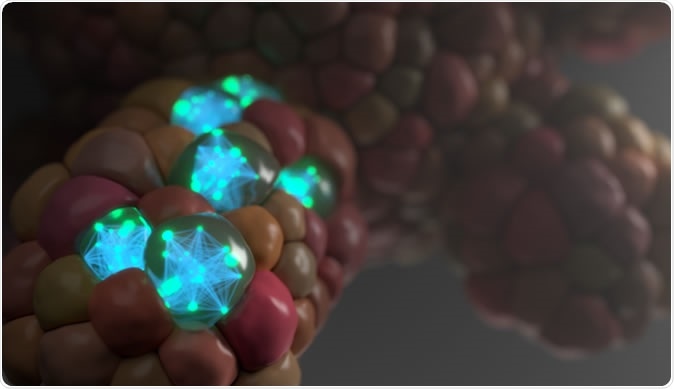Researchers from University College London have devised a new way by which they could decipher the language cancer cells use to communicate among themselves. They found this unique method of communication between the cancer cells in organoids or collections of cells mimicking a mini organism in the lab. The study titled, "Cell-Type Specific Signaling Networks in Heterocellular Organoids," was published in the latest issue of the journal Nature Methods.

Intestinal organoid showing signaling networks within the cells
Organoids are mini-collections of cells that are created from stem cells and coaxed into growing into tiny organisms. These organoids can mimic a living system and thus are useful in studying drugs and chemicals and their actions on the cells. The organoids are also valuable 3-dimensional structures grown in the Petri dishes of the labs that can be used to study various pathological conditions, including cancers. These collection of cells are unlike a regular clump of cells but contain immune cells as well as connective tissues in addition to the cancer cells or tumor cells. The behavior of the tumor cells mimics its actual behavior in the body around other healthy cells, and immune cells explained the researchers.
The team of researchers from UCL for the first time have shown that cancer cells could be using a unique signaling system to communicate with each other. They noted that there were some signaling molecules that individuals cells had and these were also found in the miniature replicas of the tumors. They wrote that these molecules and these communications are helping the cancer cells to escape being killed by the body's immune system or the chemotherapy and other cancer treatments.
According to the team, this finding could help them develop new drugs that could help prevent the tumors from communicating with each other and thus help kill them. Response to the existing therapies could be improved, the team explained. Doctors could also help select the best possible treatment that the tumors could respond best to treatment.
The authors add that they could use these organoids to understand the tumors in the labs before selecting the best course of treatment for the cancer patient. Using this new technique of individual cell communication with others in the organoids, they could find communication or signaling molecules and tweak the molecules so that the target cells do not receive the message and escape treatment.
According to the lead researcher of the study, Dr. Chris Tape, "Organoids are already revolutionizing cancer research by allowing us to test whether experimental new drugs are effective on lifelike models of tumors. But crucially, this new technique helps scientists to understand why a treatment works or not, by revealing in unprecedented detail how cells are talking to each other."
After creating the organoids, the team used mass cytometry. Mass cytometry is a technique that can help detect and analyze proteins in a sample. These proteins were essentially the signaling molecules, wrote the researchers. They explained that immune cells release antibodies – or special proteins, to fight off the cancer cells and other foreign cells in the body. The researchers added then that they broke up the organoids into individual cells and combined the antibodies with heavy metal ions. The antibodies then bound to the cancer signaling molecules they explained. These bound molecules could now be detected easily. The team nebulized the individual cells of the organoids to convert them into a mist. The heavy metal ions were now electrically charged, and a magnetic field could be now used to separate the molecules that were bound to antibodies containing the heavy metal atoms. This helped the team identify the signaling molecules distinctly.
For this study, the team looked at bowel cancer cells and found that there were 28 different signaling molecules that were found in 6 different types of cancer cells from the samples. The team was working with over 1 million cells. The authors explained that these signaling molecules worked on the immune system and altered the regular signaling networks in such a manner than tumors could escape the immune system and grow in an uncontrolled manner.
As of now, the findings are in the experimental stage, and their specific clinical applications remain to be seen. The team is working on perfecting their technique so that the communications between the cells could be blocked, and the cancer cells become responsive to treatment once again.
Dr. Emily Armstrong, research information manager at Cancer Research UK, in her statement, said, "Having a better understanding of this complex communication between cancer cells and other types of cell that make up a tumor could reveal secrets of how cancer comes back after treatment and spreads around the body. While this technique is in the early stages of development right now, in the future we may be able to grow replicas of individual patients' tumors, to identify early signs that a drug won't work for them so we can personalize their treatment plan. We hope this could one day help more people to survive cancer."
Journal reference:
Xiao Qin, Jahangir Sufi, Petra Vlckova, Pelagia Kyriakidou, Sophie E. Acton, Vivian S. W. Li, Mark Nitz, Christopher J. Tape, Cell-Type Specific Signaling Networks in Heterocellular Organoids. Nature Methods. https://www.nature.com/articles/s41592-020-0737-8